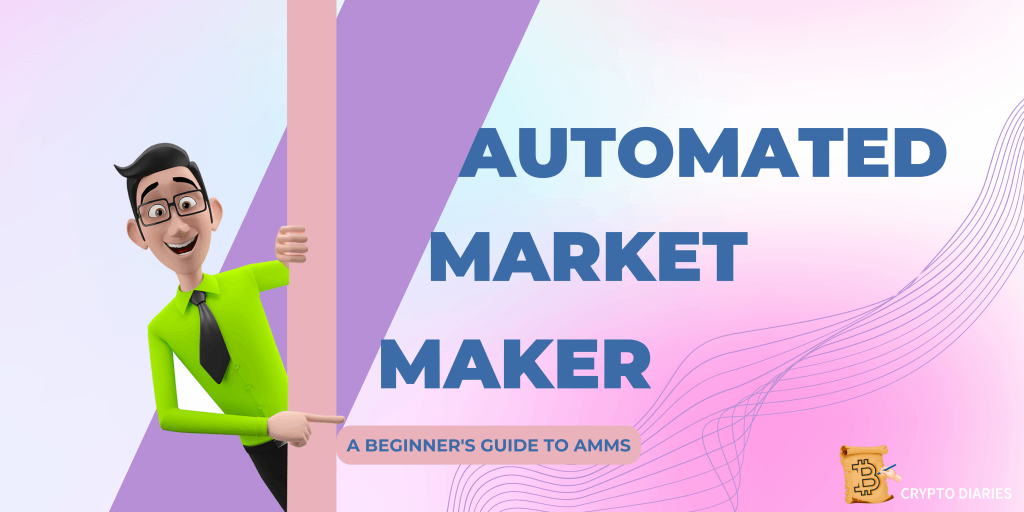After the inception of Bitcoin, the largest cryptocurrency, many other crypto projects followed. Crypto exchanges were among the first blockchain-related projects to join this digital market and allow investors to purchase crypto easily. One of the largest exchanges today, Kraken, is one of the oldest exchanges.
First came centralized exchanges, which allow traders to purchase and sell tokens easily using the order book system. However, for any success, exchanges needed a continuous supply of liquidity. Therefore, most centralized exchanges rely on third parties to get liquidity. Those external parties are called market makers. This guide looks into market makers, mainly focusing on AMM.
Market Makers Explained
Before delving deep into the world of automated market makers, it’s vital to understand what a market maker is. In the financial markets, a market maker is a trusted party whose main objective is providing liquidity to allow buyers and sellers to trade efficiently.
Remember, the primary role of a crypto exchange platform is matching buyers and sellers. However, exchanges could run out of liquidity, making it almost impossible to deal with buy and sell orders.
However, to ensure they never lack liquidity, crypto exchange platforms acquired the services of market makers. Market makers may include financial institutions and even large traders. The institutions and individuals continue participating in the process of ensuring there is enough liquidity in markets.
The robust institutions often create large numbers of ask and bid orders with differing prices. When a trader makes an order in the market, the centralized exchange and the institutions will match with a ready bid. With the many ready orders, the smaller daily traders will never lack counterparties to trade with. That is market-making in the traditional centralized exchange sense. So, how do decentralized exchange platforms make markets?
Automated Market Makers
An AMM is a market maker designed to operate purely algorithmically. It’s designed to help automatically provide liquidity in decentralized markets. AMMs are algorithmic versions of market makers where a smart contract offers exchange services freely from the order book system. Buyers or investors trading via AMMs can initiate any of their token transactions directly from their wallets.
The concept of automated market makers was invented in the 1990s. However, its popularity today is mainly because of its association with DeFi-related markets. The idea of AMM helped introduce some degree of fairness in the markets.
Remember, blockchain technology allows investors to trade any time of the day. You can create a trade at any time and complete your order efficiently. AMM allows anyone to complete a trade at any time as long as there is liquidity in the pool.
How Do AMMs Work?
AMMs work in a proper digital way when compared to traditional market makers. They leverage algorithmic systems called liquidity pools. Liquidity pools are contracts created to help store the liquidity of tokens in exchanges.
Traditional markets use order book systems where an investor makes an order and waits for the fulfillment. The order book system lists assets in pairs. Instead of using pairs, AMMs offer token pools consisting of two assets. An investor can easily buy or sell either of the two assets in this pool.
Take, for instance; Trader A wants to purchase Ethereum using USDC. The marketplace must have enough ETH to purchase to make trader’s work easy. Now, the liquidity pool handles the task of providing enough liquidity for trader A and others in the market.
So, AMMs use the liquidity pools to help trader A get near-instant fulfillment of their ETH purchase. The trader needs to scour for an USDC-ETH pool to purchase the asset. In the pool, the investor will add the amount of USDC they have and receive ETH of the exact value. By doing that simple task, trader A swapped USD coin for Ethereum.
However, for the pools to have enough liquidity to supply to buyers, they need a supply of the same. So, how do pools get liquidity? Liquidity providers.
Liquidity Provision in Autonomous Market Makers
To ensure a constant supply of liquidity in pools, DEX platforms encourage people to participate in liquidity provision. Liquidity provision is simply the act of adding more tokens to a pool. Liquidity providers handle the liquidity provision tasks; they deposit various assets in the pools allowing others to trade efficiently.
As mentioned earlier, a liquidity pool contains two different assets in a fixed ratio which mainly depends on pricing. Therefore, liquidity providers add liquidity in the pools by adding the two assets needed in the pool in the ratio required at the time.
Different decentralized exchange platforms have varying formulas on how the ratio of assets in pools should be standardized. The formulas help the liquidity providers quickly add and balance the liquidity inside the pool.
In Uniswap, the formula used in standardizing liquidity is X*Y=k. X is asset A, Y is asset B, and K is a constant ratio. For instance, in an ETH/USDC pool, X is ETH, and Y is USDC. Remember, the ratio k should remain constant after the addition or removing tokens from a pool.
Remember, when a buyer purchases the ETH, the amount of ETH in the pool drops. As such, the amount/value of ETH must instantly increase to provide a balance. At this point, the value of 1 asset will reduce to ensure the ratio remains high.
A liquidity provider continues to add more liquidity, ensuring the pools have enough balance. The advantage is that the LP can easily withdraw any funds staked as they leave the pool.
Depositing assets in the pool mean the LP will gain rewards. Liquidity provision has been popularized as a way to earn passive income.
Once you withdraw your tokens from the liquidity pool, you no longer are a pool participant, hence do not stand to gain rewards. The regards from liquidity pools are collected from trading fees paid by traders. The fees are then shared across pool members depending on the investment ratio.
Examples of AMMs: Decentralized Exchange Platforms
As mentioned earlier, AMMs are simple systems designed mainly to operate at the heart of decentralized exchanges. So, in simpler terms, decentralized exchanges are automated market makers. Here are 5 top AMMs users;
UniSwap (Best AMM)
UniSwap is currently the best and most used AMM in the crypto landscape. The platform, launched to ease trades of over 614 tokens, has huge trading volumes in hundreds of millions. UniSwap was launched in 2018 and is currently the most popular AMM.
Pancakeswap (BSC Based)
Pancakeswap is the largest decentralized exchange platform on the Binance smart chain. Like Uniswap, Pancakeswap also leverages AMMs to offer exchange services mainly for DeFi tokens based on Binance Smart Chain.
Curve Finance
While AMMs are primarily used for DeFi tokens, Curve offers DEX services by aggregating stablecoins into liquidity pools. Once you deposit tokens onto Curve pools, you receive LP tokens in return. However, when you withdraw, you get stablecoins.
SushiSwap (ETH Based)
The second largest Ethereum-based DEX platform SushiSwap also offers excellent AMM services to ease DeFi token trading. As the biggest Uniswap competitor, SushiSwap has recorded massive daily trading volumes owing to its reliable services.
Balancer
Another platform, Balancer, was designed to offer excellent AMM services for participants within the DeFi landscape. Balancer has unique features, including dynamic pool fees, multi-token pools, custom pool ratios etc.
SolanaX (Solana Based)
Another popular AMM is SolanaX, a decentralized exchange platform based on the Solana chain. The DEX serves mostly tokens based on the Solana chain.
There are indeed other blockchain networks hosting different decentralized exchanges. Among them include Loopring, Cardano, Avalanche, Polygon and many more. It’s up to the trader to decide what platform interests them.
Pros and Cons of AMM
Automated market makers offer a wide range of benefits for the average investor. Some of these benefits are almost impossible to replicate using centralized exchange platforms. The most popular advantages at the moment include the following;
- Complete decentralization — As mentioned above, AMMs are unique systems created for decentralized exchange platforms. These platforms are always highly decentralized, using the power of smart contracts and community governance. Even transactions therein are decentralized.
- Non-custodial — AMMs do not take custody of an individual trader’s assets. The trader triggers transactions immediately from their crypto wallets.
- Secure — By decentralizing, AMMs remain safe from attacks. Even more, since everything is distributed, hackers would find it hard to interact with individual users of the pools.
- Cannot be manipulated — Market manipulation is quite prevalent in CEXes, with some investors even taking advantage of insider information. In DEXes, it’s almost impossible to manipulate prices due to decentralization.
- Easy access to tokens — Centralized exchanges have long vouching and verification protocols before listing tokens. However, in DEXs, anyone has the freedom to list an asset fostering even further decentralization.
While AMMs have a wide range of pros, there is also a downside. Mainly, in AMMs, the fees are relatively higher than CEX because of blockchain gas charges.
Participants in AMMs
So, which parties constitute an AMM? Well, there are very many participants in each AMM, including;
- The team — AMM’s creators and development team are the main participants. Essentially, the team helps in marketing and forming decentralized organizations.
- Liquidity providers and LP tokens — As already discussed, liquidity providers help offer token liquidity in the markets. Once you deposit liquidity, you receive LP tokens.
- Traders and swappers — Every AMM must also have users who are mainly traders/swappers. These focus on using the DEX to buy or sell different tokens. Some may be purchasing for trading reasons.
- Arbitrageurs — These are essentially investors who compare prices between CEXs and DEXs and take advantage of any short-term price differences.
In Conclusion
This guide explores the entire concept of automated market makers, how they work, and their benefits. AMMs were developed to help ensure traders in the DeFi landscape always get liquidity for trading their tokens. However, the platforms also rely on liquidity providers to help ensure there is enough market liquidity. Liquidity provision is an excellent way to earn passive income in AMMs.
Many AMMs are available today, each with unique features in different blockchains. When choosing an AMM to work with, consider the blockchain, fees, services offered, technology, and even reputation.

